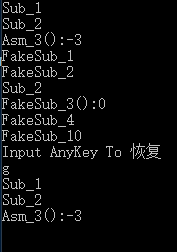[原創]MinHook測試與分析(x64下 E9,EB,CALL指令測試,且逆推測試微軟熱補丁)
依稀記得第一次接觸Hook的概念是在周偉民先生的書中-><<多任務下的數據結構與算法>>,當時覺得Hook很奇妙,有機會要學習到,正好近段日子找來了MiniHook,就一起分享一下。
本篇文章是在x64下測試與分析jmp+offset類型的Hook,並且逆推測出熱補丁的簡單用法,MinHook它的中心就是覆蓋重寫並且可以復原。知道大概的思路後後讓我們先來具體的實現MinHook再去做測試。
首先是堆的申請(申請PAGE_SIZE大小自動生長的堆),以下是實現與卸載
1 NTSTATUS WINAPI Initialize(VOID)
2 {
3 NTSTATUS Status = STATUS_SUCCESS;
4
5 EnterSpinLock();
6
7 if (__HeapHandle == NULL)
8 {
9 __HeapHandle = HeapCreate(0,//申請堆棧
10 0, //提交 PAGE_SIZE
11 0); //If dwMaximumSize is 0, the heap can grow in size.自動增長
12 if (__HeapHandle != NULL)
13 {
14 //沒有實現
15 }
16 else
17 {
18 Status = STATUS_MEMORY_NOT_ALLOCATED;
19 }
20 }
21 else
22 {
23 Status = STATUS_ADDRESS_ALREADY_EXISTS;
24 }
25
26 LeaveSpinLock();
27
28 return Status;
29 }
30
31 NTSTATUS WINAPI Uninitialize(VOID)
32 {
33 NTSTATUS Status = STATUS_SUCCESS;
34
35 return Status;
36 }
第一幕CreateHook
CreateHook 第一步:判斷內存是否申請好了,是否可執行,判斷是否已經Hook過了,如果已經Hook過,當讓他返回其所在位置,因為此時他的地址位置已經可以用來啟動Hoook,如下代碼詳解
1 UINT FindHookEntry(LPVOID FunctionAddress)
2 {
3 UINT i;
4 for (i = 0; i < __Hooks.Length; ++i)
5 {
6 if ((ULONG_PTR)FunctionAddress == (ULONG_PTR)__Hooks.Items[i].TargetFunctionAddress)
7 return i;
8 }
9 return STATUS_NOT_FOUND;
10 }
CreateHook 第二步:進行Hook,在這裏用到TRAMPOLINE結構體,我稱之為跳板結構體,作為數據的中間傳輸過渡,TRAMPOLINE中幾個註意的成員是1.Relay:在x64下Fake函數到原函數的中轉站(x86用不到),2.OldIPs:原函數地址的偏移字節的保存3.NewIPs: 已經寫入FakeFunctionAddress函數的字節數 4.MemorySlot:32字節原函數地址的前7個字節和跳轉指令後的字節 5.PachAbove:熱補丁
1 typedef struct _TRAMPOLINE
2 {
3 LPVOID TargetFunctionAddress; // [In] Address of the target function.
4 LPVOID FakeFunctionAddress; // [In] Address of the detour function.
5 LPVOID MemorySlot; // MemorySlot 32字節原函數地址的前五個字節和跳轉指令後的字節
6
7 #if defined(_M_X64) || defined(__x86_64__)
8 LPVOID Relay; // [Out] Address of the relay function.
9 #endif
10 BOOL PatchAbove; // [Out] Should use the hot patch area? //Patch --->熱補丁哦 //0xA 0xB
11 UINT IP; // [Out] Number of the instruction boundaries.
12 UINT8 OldIPs[8]; // [Out] Instruction boundaries of the target function.
13 UINT8 NewIPs[8]; // [Out] Instruction boundaries of the trampoline function.
14 } TRAMPOLINE, *PTRAMPOLINE;
CreateHook 第三步: 分配一塊內存用來保存Trampoline裏的MemorySlot數據 ,以下是MemorySlot結構體定義(MemorySlot內存構建放到最後的代碼鏈接中):
1 #define MEMORY_BLOCK_SIZE 0x1000
2 #if defined(_M_X64) || defined(__x86_64__)
3 #define MEMORY_SLOT_SIZE 64
4 #else
5 #define MEMORY_SLOT_SIZE 32
6 #endif
7
8 // Max range for seeking a memory block. (= 1024MB)
9 #define MAX_MEMORY_RANGE 0x40000000
10
11 typedef struct _MEMORY_SLOT
12 {
13 union
14 {
15 struct _MEMORY_SLOT *Flink;//下一指針
16 UINT8 BufferData[MEMORY_SLOT_SIZE];
17 };
18 } MEMORY_SLOT, *PMEMORY_SLOT; //32字節
19
20 typedef struct _MEMORY_BLOCK
21 {
22 _MEMORY_BLOCK* Flink;
23 PMEMORY_SLOT FreeMeorySlotHead; // First element of the free slot list.空閑插槽列表的第一個元素。
24 UINT UsedCount;
25 } MEMORY_BLOCK, *PMEMORY_BLOCK; //12字節
CreateHook 第四步:CreateTrampoline
Hook的Target我們這裏先使用MessageBoxW,作為一個詳細的jmp跳轉流程解釋,然後我寫了幾個匯編程序去進行其他E8,Call等指令的跳轉實現,不過它是怎麽跳轉的我會在下面跳轉的時候貼出來,首先來玩X64下的MessageBoxW,
64位 MessageBox 00007FF97B4485A0 48 83 EC 38 sub rsp,38h 00007FF97B4485A4 45 33 DB xor r11d,r11d 00007FF97B4485A7 44 39 1D 7A 33 03 00 cmp dword ptr [gfEMIEnable (07FF97B47B928h)],r11d 00007FF97B4485AE 74 2E je MessageBoxW+3Eh (07FF97B4485DEh) 00007FF97B4485B0 65 48 8B 04 25 30 00 00 00 mov rax,qword ptr gs:[30h] 00007FF97B4485B9 4C 8B 50 48 mov r10,qword ptr [rax+48h] 00007FF97B4485BD 33 C0 xor eax,eax 00007FF97B4485BF F0 4C 0F B1 15 98 44 03 00 lock cmpxchg qword ptr [gdwEMIThreadID (07FF97B47CA60h)],r10 00007FF97B4485C8 4C 8B 15 99 44 03 00 mov r10,qword ptr [gpReturnAddr (07FF97B47CA68h)] 00007FF97B4485CF 41 8D 43 01 lea eax,[r11+1] 00007FF97B4485D3 4C 0F 44 D0 cmove r10,rax 00007FF97B4485D7 4C 89 15 8A 44 03 00 mov qword ptr [gpReturnAddr (07FF97B47CA68h)],r10 00007FF97B4485DE 83 4C 24 28 FF or dword ptr [rsp+28h],0FFFFFFFFh 00007FF97B4485E3 66 44 89 5C 24 20 mov word ptr [rsp+20h],r11w 00007FF97B4485E9 E8 A2 FE FF FF call MessageBoxTimeoutW (07FF97B448490h) 00007FF97B4485EE 48 83 C4 38 add rsp,38h
前面講過我們是通過跳轉加指令形式跳轉到我們需要到的地址處,上面代碼註釋中我們了解到OldPos與NewPos是在MemorySlot創建過程對原函數地址的偏移字節的保存和已經寫入FakeFunctionAddress函數的字節數,如下
1 ULONG_PTR OldInstance = (ULONG_PTR)Trampoline->TargetFunctionAddress + OldPos; 2 ULONG_PTR NewInstance = (ULONG_PTR)Trampoline->MemorySlot + NewPos; 3 //數據 4 //OldPos是指的指令的偏移字節 即5個字節中的第2345位.OldInstance地址 5 //指令長度
了解到一些後,我們就應該去真正的對MemorySlot去構建,他的構建用了一個超級大的do-While()循壞(因為實踐了好幾種跳轉指令,心累),x86下的MessageBoxW跳轉在5字節處,所以為了之後的恢復,我們需要把7字節的內容做一個保存,這就是所謂的OriginalDataBackup數組的作用->用來恢復也就是解除Hook,後面會逐步解析他的作用和位置,我們這裏先記住即可
MemorySlot開始申請32字節的長度,,我們利用反匯編引擎HDE計算出MessageBoxW函數基地址,從上面給出的MessageBoxW的地址內容中,我們可以看到到達5字節的加法是先加4個字節到下一地址,然後加3到跳轉位置,記錄在OldPos,NewPos中
CopyCodeLength = HDE_DISASM((LPVOID)OldInstance, &hde);
if (hde.flags & F_ERROR)
{
return FALSE;
}
CopyCodeData = (LPVOID)OldInstance;
.....
Trampoline->OldIPs[Trampoline->IP] = OldPos;
Trampoline->NewIPs[Trampoline->IP] = NewPos;
Trampoline->IP++;
到達7字節了,我們就可以去做跳回MessageBoxW基地址加5字節偏移跳轉指令了
1if (OldPos >= sizeof(JMP_REL))
{
// The trampoline function is long enough.
#if defined(_M_X64) || defined(__x86_64__)
//OldInstance = 00007FF97B4485A7;
jmp.Address = OldInstance;
#else
//OldInstance = 74CA8B85
//目標 = 源 + Offset + 5
//Offset = 目標 - (源 + 5)
jmp.Operand = (UINT32)(OldInstance - (NewInstance + sizeof(jmp))); //計算跳轉到目標的偏移
#endif
CopyData = &jmp;
CopyDataLength = sizeof(jmp);
IsLoop = TRUE;
}
1 //這裏是熱補丁的判斷 是否有足夠的位置長跳轉
2 if (OldPos < sizeof(JMP_REL)
3 && !IsCodePadding((LPBYTE)Trampoline->TargetFunctionAddress + OldPos, sizeof(JMP_REL) - OldPos))
4 {
5
6 // Is there enough place for a short jump?
7 //沒有有足夠的位置長跳轉,那是否有足夠的位置短跳轉?
8 if (OldPos < sizeof(JMP_REL_SHORT)
9 && !IsCodePadding((LPBYTE)Trampoline->TargetFunctionAddress + OldPos, sizeof(JMP_REL_SHORT) - OldPos))
10 {
11 return FALSE;
12 }
13 //只能寫短跳轉,使用熱補丁
14 // Can we place the long jump above the function?
15 //熱補丁:目標地址之前地址是否可執行?
16 if (!SeIsExecutableAddress((LPBYTE)Trampoline->TargetFunctionAddress - sizeof(JMP_REL)))
17 return FALSE;
18 //目標地址之前是否是可被覆蓋的空白
19 if (!IsCodePadding((LPBYTE)Trampoline->TargetFunctionAddress - sizeof(JMP_REL), sizeof(JMP_REL)))
20 return FALSE;
21 //標誌可以熱補丁
22 Trampoline->PatchAbove = TRUE;
做了這麽多工作,無非是為了MemorySlot裏有數據前7個字節和跳轉回MessageBoxW基地址+5字節的的偏移,構造好後,我們的TRAPOLINE結構也就完成
CreateHook第五步:添加Hook信息了(TRAMPLIONE結構體過渡),我們需要再去創建一個HookEntry的結構體去完成接收信息
1 // Hook information.
2 typedef struct _HOOK_ENTRY
3 {
4 LPVOID TargetFunctionAddress; //目標地址
5 LPVOID FakeFunctionAddress; //Fake地址即覆蓋地址
6 LPVOID TrampolineMemorySlot; // Address of the trampoline function.
7 UINT8 OriginalDataBackup[8]; // Original prologue of the target function.目標功能的原始序幕- //恢復Hook使用的存放原先數據
8
9 UINT8 PatchAbove : 1; // Uses the hot patch area. 備份原函數的5字節,重要!!!
10 UINT8 IsEnabled : 1; // Enabled.啟用或者關閉
11 UINT8 queueEnable : 1; // Queued for enabling/disabling when != isEnabled.
12
13 UINT IP : 4; // Count of the instruction boundaries.索引 想到匯編的IP就很明白了
14 UINT8 OldIPs[8]; // Instruction boundaries of the target function.原地址的字節變化就靠它了
15 UINT8 NewIPs[8]; // Instruction boundaries of the trampoline function 用在後續解釋的MemorySlot中
16 } HOOK_ENTRY, *PHOOK_ENTRY; //44字節
17
18
19 typedef struct _HOOK_INFORMATION_
20 {
21 PHOOK_ENTRY Items; // Data heap
22 UINT MaximumLength; // Size of allocated data heap, items
23 UINT Length; // Actual number of data items
24 }HOOK_INFORMATION,*PHOOK_INFORMATION;
當有了這個結構體後就可以去CreateHook了,下面是構建過程:
1 if (CreateTrampoline(&Tl))
2 {
3 PHOOK_ENTRY HookEntry = AddHookEntry(); //填充一個HookInfo信息
4 if (HookEntry != NULL)
5 {
6 HookEntry->TargetFunctionAddress = Tl.TargetFunctionAddress;
7 #if defined(_M_X64) || defined(__x86_64__)
8 HookEntry->FakeFunctionAddress = Tl.pRelay;//跳轉在trampoline
9 #else
10 HookEntry->FakeFunctionAddress = Tl.FakeFunctionAddress;
11 #endif
12 HookEntry->TrampolineMemorySlot = Tl.MemorySlot;
13 HookEntry->PatchAbove = Tl.PatchAbove
14 HookEntry->IsEnabled = FALSE;
15 //HookEntry->QueueEnable = FALSE;
16 HookEntry->IP = Tl.IP;
17
18 memcpy(HookEntry->OldIPs, Tl.OldIPs, ARRAYSIZE(Tl.OldIPs));
19 memcpy(HookEntry->NewIPs, Tl.NewIPs, ARRAYSIZE(Tl.NewIPs));
20
21 // Back up the target function.
22
23 if (Tl.PatchAbove)//這就是熱補丁
24 {
25 memcpy(
26 HookEntry->OriginalDataBackup,
27 (LPBYTE)TargetFunctionAddress - sizeof(JMP_REL),
28 sizeof(JMP_REL) + sizeof(JMP_REL_SHORT));
29 }
30 else
31 { //存儲源函數的數據內容
32 memcpy(HookEntry->OriginalDataBackup, TargetFunctionAddress, sizeof(JMP_REL));
33 }
34 if (OriginalWhitelist != NULL)//白名單,用來恢復
35 {
36 *OriginalWhitelist = HookEntry->TrampolineMemorySlot;
37 }
到這裏為止終於是創建了Hook
第二幕 EnableHook
顧名思義就是啟動Hook,顯而易見得知它的作用無非就是覆蓋原函數我們記錄的那7字節,如下:
1 //SHELLCODE 2 PJMP_REL jmp = (PJMP_REL)PatchData; 3 jmp->Opcode = 0xE9;//跳轉 4 jmp->Operand = (UINT32)((LPBYTE)HookEntry->FakeFunctionAddress - (PatchData + sizeof(JMP_REL))); 5
當需要解除Hook時候我們就可以用到在前面說過的OriginalDataBackup去恢復原函數,或者直接調用MemorySlot中記錄下的原始序幕
1 else
2 {
3 memcpy(PatchData, HookEntry->OriginalDataBackup, sizeof(JMP_REL));
4 }
第三幕 MessageBoxW測試
1 if (CreateHook(&MessageBoxW, &FakeMessageBox,
2 reinterpret_cast<LPVOID*>(&__OriginalMessageBoxW)) != STATUS_SUCCESS)//告知要hook成什麽樣子
3 {
4 return;
5 }
6
7 MessageBoxW(0, L"MessageBoxW", L"MessageBoxW", 0);//沒有Hook還是原先,不要也行
8 if (EnableHook(MessageBoxW) != STATUS_SUCCESS)
9 {
10 printf("EnableHook is wrong\r\n");
11 return;
12 }
13 MessageBoxW(NULL, L"CreateHook()", L"CreateHook()", 0);//啟動Hook後,現在是FakeHOOK
14
15 printf("Input AnyKey To Exit\r\n");
16 getchar();
17
18 Uninitialize();//返回釋放
19 }
20
21 int WINAPI FakeMessageBox(
22 _In_opt_ HWND DialogHwnd,
23 _In_opt_ WCHAR* DialogText,
24 _In_opt_ WCHAR* DialogCaption,
25 _In_ UINT Type
26 )
27 {
28 __OriginalMessageBoxW(DialogHwnd, L"FakeMessageBox", L"FakeMessageBox", Type);
29 return 0;
30 }
編譯運行後出結果啦,先是原先的MessageBoxW:

這是成功Hook後的:

一切順利,沒有白費功夫,下面是我對EB,call,熱補丁的匯編源碼,我們仿照MessageBoxW的形式在test.cpp中定義函數指針,與Fake函數的輸出形式。
在這裏花費了功夫探索出了熱補丁的簡單定義是申請5字節空的內存然後 mov edi,edi,能應用正確,匯編代碼如下
.DATA
MessageBoxW dq 0
.CODE
Asm_OnInitMember PROC
mov qword ptr[rsp+8h],rcx
push rbp
push rdi
sub rsp,28h
mov rax,qword ptr[rsp+28h+8h+8h+8h]
mov MessageBoxW,rax
add rsp,28h
pop rdi
pop rbp
ret
Asm_OnInitMember ENDP
Asm_1 PROC
mov qword ptr[rsp+8h],rcx
push rbp
push rdi
sub rsp,28h
xor rbx,rbx
;00007FF77A8012BC E9 7A 0B 00 00 jmp Asm_4 (07FF77A801E3Bh)
mov rax,qword ptr[rsp+28h+8h+8h+8h]
mov ebx,dword ptr[rax+1]
add rax,rbx
add rax,5
add rsp,28h
pop rdi
pop rbp
ret
Asm_1 ENDP
Asm_3 PROC
jmp Label1
Label1:
jmp Label2
Label2:
mov eax,-3
ret
Asm_3 ENDP
Asm_4 PROC
call Label0
jmp Exit;
Label0:
mov rcx,0;
call Label1; //Call
db ‘H‘
db 0
db ‘e‘
db 0
db ‘l‘
db 0
db ‘l‘
db 0
db ‘o‘
db 0
db ‘S‘
db 0
db ‘u‘
db 0
db ‘b‘
db 0
db ‘_‘
db 0
db ‘4‘
db 0
db 0
db 0
Label1:
pop rdx
call Label2;
db ‘H‘
db 0
db ‘e‘
db 0
db ‘l‘
db 0
db ‘l‘
db 0
db ‘o‘
db 0
db ‘S‘
db 0
db ‘u‘
db 0
db ‘b‘
db 0
db ‘_‘
db 0
db ‘4‘
db 0
db 0
db 0
Label2:
pop r8
mov r9,0
call MessageBoxW
ret
Exit:
ret
Asm_4 ENDP
Asm_10 PROC
db 0CCh
db 0CCh
db 0CCh
db 0CCh
db 0CCh
mov edi,edi
ret
Asm_10 ENDP
END
1 //熱補丁測試
typedef void(*LPFN_SUB_10)();
void FakeSub_10(); //熱補丁
LPFN_SUB_10 __OriginalSub_10 = NULL;
2
PVOID v10 = Asm_1(Asm_10);
3
4 if (SeCreateHook((PVOID)((ULONG_PTR)v10 + 5), &FakeSub_10,
5 reinterpret_cast<LPVOID*>(&__OriginalSub_10)) != STATUS_SUCCESS)
6 {
7 return;
8 }
9 //對於熱補丁函數調用
10 ((LPFN_SUB_10)(((ULONG_PTR)v10 + 5)))();
11 if (SeEnableHook(ALL_HOOKS) != STATUS_SUCCESS)
12 {
13 printf("SeEnableHook() Error\r\n");
14 return;
15 }
16 ((LPFN_SUB_10)(((ULONG_PTR)v10 + 5)))();
E9的測試只需要自寫一個函數調用測試調用即可,如下面這樣就行了然後在仿照上面自行測試即可
1 1 //E9指令,這樣就行了
2 2
3 3 void Sub_2()
4 4 {
5 5 printf("Sub_2\n\r");
6 6 }
下面是所有的正確輸出結果:

好了,x86下的MiniHook終於是測試完了,寫了一遍後又是更懂了,如果有什麽差錯,望大家糾正
[原創]MinHook測試與分析(x64下 E9,EB,CALL指令測試,且逆推測試微軟熱補丁)
